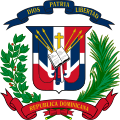
Dominicans are an ethno-national people, a people of shared ancestry and culture, who have ancestral roots in the Dominican Republic. The Dominican ethnic group was born out of a fusion of European, native Taino, and African elements, which is an ethnic fusion that goes back to the 16th century. Due to this fusion, the majority of Dominicans are of mixed-race heritage, tracing roots mainly to these three sources with the vast majority being of predominant European ancestry. The demonym Dominican can be traced as far back as the 1621. The name came from Santo Domingo, which was not only the name of the capital city but also of the entire island at the time, Spain used this term to refer to the inhabitants of Spanish province of Santo Domingo. Recent immigrants and their children, who are legal citizens of the Dominican Republic, can be considered "Dominican" by nationality but not ethnicity due to not having ancestral roots in the country.

The coat of arms of the Argentine Republic or Argentine shield was established in its current form in 1944 but has its origins in the seal of the General Constituent Assembly of 1813. It is supposed that it was chosen quickly because of the existence of a decree signed on February 22 sealed with the symbol. The first mention of it in a public document dates to March 12 of that same year, in which it is stated that the seal had to be used by the executive power, that is, the second triumvirate. On April 13 the National Assembly coined the new silver and gold coins, each with the seal of the assembly on the reverse, and on April 27 the coat of arms became a national emblem. Although the coat of arms is not currently shown on flags, the Buenos Aires-born military leader Manuel Belgrano ordered to paint it over the flag he gave to the city of San Salvador de Jujuy, and during the Argentine War of Independence most flags had the coat of arms.

The coat of arms of Bolivia has a central cartouche surrounded by Bolivian flags, cannons, laurel branches, and has an Andean condor on top.

The flag of the Dominican Republic represents the Dominican Republic and, together with the coat of arms and the national anthem, has the status of a national symbol. The blue on the flag stands for liberty, the white for salvation, and the red for the blood of heroes. The civil flag follows the same design, but without the charge in the center. The flag was designed by Juan Pablo Duarte.

The flag of El Salvador features a horizontal triband of cobalt blue-white-cobalt blue, with the coat of arms centered and entirely contained within the central white stripe. This design of a triband of blue-white-blue is commonly used among Central American countries. El Salvador's flag is one of few that currently use the color purple, due to the rainbow in its coat of arms.

The flag of Haiti is the national flag of the Republic of Haiti. It is a bicolour flag featuring two horizontal bands coloured blue and red, emblazoned by a white rectangular panel bearing the coat of arms of Haiti. The coat of arms depicts a trophy of weapons atop a green hill and a royal palm symbolizing independence. The palm is topped by the Cap of Liberty. The motto L'Union fait la Force appears on a white ribbon below the arrangement.

The coat of arms of Chile dates from 1834 and was designed by the English artist Charles Wood Taylor (1792–1856). It is made up by a figurative background divided in two equal parts: the top one is blue and the bottom, red. A five pointed white star is in the centre of the shield. This background is supported in one side by a condor, the most significant bird of prey from the Andes, and in the other, by a huemul, a mammal endemic to Chile. Both animals wear golden naval crowns symbolising the heroic deeds of the Chilean Navy in the Pacific Ocean.

The coat of arms of Malta is the national coat of arms of the country of Malta.

The national emblem of East Timor is one of the national symbols of East Timor.
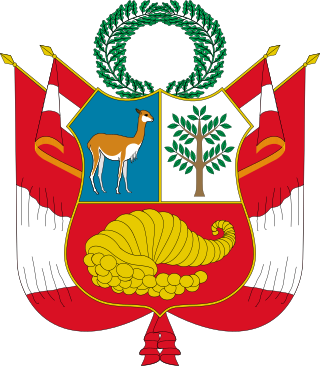
The Coat of arms of Peru is the national symbolic emblem of Peru. Four variants are used: the Coat of arms per se ; the National Coat of arms, or National Shield ; the Great Seal of the State ; and the Naval Coat of arms.
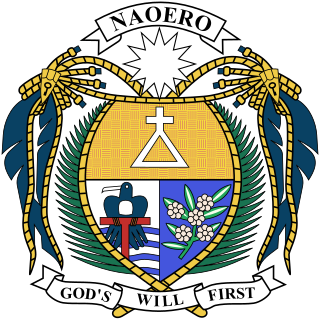
The design of the coat of arms of the Republic of Nauru originated in 1968 following the declaration of independence, and it began to be used officially in the early 1970s.
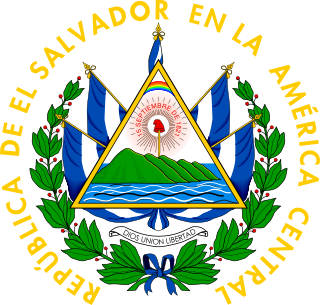
The coat of arms of El Salvador has been in use in its current form since 15 September 1912.

The coat of arms of Haiti is the national coat of arms of the Republic of Haiti. It was originally introduced in 1807, and it has appeared in its current form since 1986. Since this Haitian national symbol does not conform to the rules of heraldry for a traditional coat of arms, then it could be considered a national emblem instead.
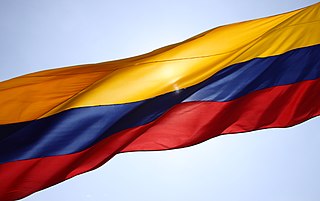
The National symbols of Colombia are the symbols which represent the national identity of the Republic of Colombia as a sovereign state. The national symbols intend to represent the Colombian identity by creating visual, verbal cultural iconic representations of the national people, values, goals, and history.

Juan Bautista Cambiaso, né Giuseppe Giovanni Battista Cambiaso, was a Genoese-born sailor and soldier, best known for helping establish the naval forces of the nascent Dominican Republic during its war of emancipation. He was the first admiral of the Dominican Navy and is considered its founder.

Mixed Dominicans, also referred to as mulatto, mestizo or historically quadroon, are Dominicans who are of mixed racial ancestry. Representing 73.9% of the Dominican Republic's population, they are by far the single largest racial grouping of the country.

The flag of the president of Colombia consists, like the flag of Colombia, of a rectangle in yellow, blue and red triband in a 2:1:1 ratio, meaning three horizontal stripes, with yellow at the top occupying half the width of the flag, blue at the bottom. middle occupying a quarter of the width and red below, occupying the last quarter, finished off in the central part with the coat of arms of Colombia.
The Color and Flag of the President of Colombia shall consist of three horizontal bands, with yellow occupying half of the upper part, and the other two colors the other half, divided into equal bands, blue in the center and red in the lower part, as well as the Coat of Arms in the central part. The proportions of the elements of the Coat of Arms will be in direct relation to the hoisting, and the flight will vary according to the customs of the military and naval services.
Jeannette Miller is a writer, poet, narrator essayist and art historian of Dominican art. She was awarded the National Literature prize from her country in 2011.











